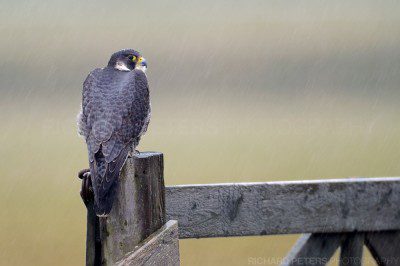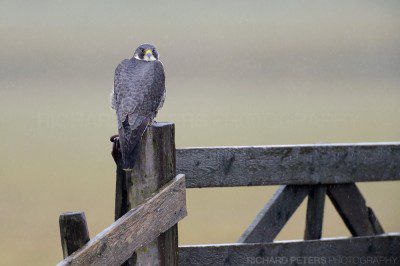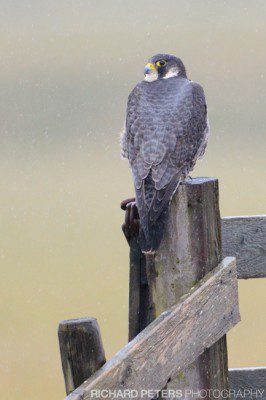Sometimes, you just get lucky!
After spending a week on the island of Texel, Holland, in the fog and rain both myself and friend, fellow photographer Rene De Heer had all but given up hope of getting anything out of the ordinary. We had even at one point considered coming home early and cancelling the rest of the trip due to the awful conditions. However, we stuck it out and on our last day were rewarded with a fantastic opportunity to photograph this traditionally quite difficult subject.

Peregrine Falcon in the rain
Main Shot details
Camera: Nikon D3
Lens: Nikon 600mm + 1.4x Teleconverter
Settings: 1/100, f6.3, ISO 280
Extras: Skimmer sack beanbag from Naturescapes.net and ThinkTank Photo Hydrophobia 300-600 rain cover
Location: The island of Texel, Holland
Bird I.D. please
Driving round the island of Texel for a week in the fog, rain and cold isn’t the dream scenario for wildlife photography. Despite that, we knew there were plenty of subjects, including numerous birds of prey, dotted about so we were optimistic of getting something in the bag on our final day. The weather was dull, there was rain & drizzle in the air but at least visibility was improved over the last few days, as the fog had all but lifted. I had developed the habit of looking at fence posts along the roads as every once in a while you would get a Sparrow Hawk or Buzzard perched up. Of course once you got within anything remotely close to shooting distance they’d be off. However, every chance we got we still tried. On this occasion we were driving along the road scouring a field for Hare when I happened to glance to my left, as we past one of the many gates that lead in to the fields, ‘Sparrow Hawk’ I said as I caught a glimpse of this bird perched up. We carried on down the road to a safe distance were Rene spun the car round, before slowly making our way back towards the gate, expecting whatever it was to be long gone. As we slowly approached Rene looked through his binoculars, ‘bloody hell’ he said with in an excited tone, ‘do you know what we are looking at here?’. Again I said I thought it was a Sparrow Hawk, to which Rene corrected me, ‘no, this is a Peregrine Falcon!’ (at this point before you all start laughing at me, I should point out although it’s getting better, my bird ID isn’t brilliant! I’m a photographer first and a bird spotter second – maybe even third). Despite not knowing at first glance what we had found I knew as soon as Rene confirmed what it was we were on to something special here, and both of us went from slightly down and out about the week to complete excitement in the space of about half a second. I’d never even seen one of these in the wild before and suddenly, here we were potentially presented with the opportunity to photograph one!

600 + 1.4x, 1/500, f6.3, ISO 1100
Slowly moving forward
We made our way along the road, towards the Peregrine, slowly. Of course our luck being the way it was the bird was now on the wrong side of the car for Rene to get any shots. So, we had to drive past for a second time, hope we didn’t scare it off, turn round and then drive back to try for some images. As we drove past again the Peregrine watched us the whole time, almost as if to say ‘why are you bothering, you know I’m going to fly off just as you get in position’. But we managed to make our way past and up the road some distance to turn around for the second time and begin our third and final approach.

600 + 1.4x, 1/1000, f6.3, ISO 3200
Easy does it
The plan was simple, and if you are a wildlife photographer you’ll know the drill – it’s the same in a car as it is on foot …get your camera ready, and approach very slowly before stopping, taking a few shots just to get ‘something’ from a distance before going forward a little more and taking some more shots, repeat until within a decent range of your subject that allows you to get the images you want whilst respecting the subjects well being. We crept slowly forward, the whole time the Falcon was getting bigger in the frame and the whole time we were both thinking to ourselves, the next push forward is going to be the last. However, finally we got a break and were allowed close enough to this beautiful bird of prey to get some images. Of course, all too quickly the moment was gone as the Falcon decided to take flight after giving us those few precious shots – however, despite the panic to get something before it flew off I managed to try a couple of different settings, with fast shutter speeds to freeze the rain and slow ones to get some streaks. Unfortunately the background was quite light so the rain is a lost, especially at low res but on the originals it does look quite nice.
Neither of us could believe our luck that we managed to get within that kind of range of this elusive bird of prey. And whilst they may not be action packed images, I think they are nice environmental portraits of a difficult subject. If you’re a wildlife photographer, you’ll no doubt know the exact feeling of excitement we went through if you’ve found yourself in a right place at the right time scenario of your own. That one brief encounter made the whole week worth while, and that’s the way it goes with wildlife photography, you have to commit lots of time and effort but when it pays off there’s no feeling like it. We also met up with photographer Marc Plomp who lives on Texel and runs the company and website Natuur Digitaal, . He knows pretty much everything about what has been spotted on the island in terms of wildlife and was thrilled with the shots we got of this beautiful bird, and promptly asked for permission to put them on the site Waarneming – which shows photos of sightings around the island and neighbouring areas.
As I said, a Peregrine Falcon, in the wild, in the rain? Yep, sometimes you just get lucky!








